Jan. 6 rioter blames his participation on Trump, false claims of election fraud: Day 7 recap
WASHINGTON – The Jan. 6 committee investigating the Capitol attack focused its seventh hearing Tuesday on how former President Donald Trump summoned protesters to Washington and directed a mob he allegedly knew was armed to the U.S. Capitol.
Here's what happened at Tuesday's hearing:
GOP lawmakers met with Trump about overturning election: Several Republican members of Congress met Dec. 21 with Trump and top advisers to discuss what role Vice President Mike Pence could play in overturning election results. They included: Brian Babin, R-Tx.; Andy Biggs, R-Ariz.; Matt Gaetz, R-Fla.; Louie Gohmert, R-Texas; Paul Gosar, R-Ariz.; Andy Harris, R-Md.; Jody Hice, R-Ga.; Jim Jordan, R-Ohio; and Scott Perry, R-Pa. Marjorie Taylor Greene, who at the time had been elected to Congress but not sworn in, also attended.
Linking Flynn, Stone to Oath Keepers, Proud Boys: Committee member Jamie Raskin, D-Md., said Tuesday that former Trump advisers Michael Flynn and Roger Stone both had connections to the Oath Keepers and the Proud Boys, showing photos of Flynn with members and pointing to communications between Stone and group leaders.
Trump’s Dec. 19 tweet triggered supporters: The committee tried to show how Trump’s tweet on Dec 19 inviting protestors to Washington helped lead to the attack on Jan. 6. protests in Washington. One group, Women for America First, changed their permit request for a rally from late January to Jan. 6 after his tweet.
Trump’s National Intelligence director feared Trump election challenges could prove ‘dangerous’: In earlier testimony to the committee but first aired Tuesday, former White House aide Cassidy Hutchinson said Trump’s director of national intelligence, John Ratcliffe, told her he thought that the former president’s election challenges could “spiral out of control” and become potentially “dangerous.”
Cheney: Trump no ‘child’: Committee Vice Chair Liz Cheney, R-Wyo., dismissed as “nonsense” Trump’s claims that he did not know that he lost the 2020 election given how his advisers repeatedly told him Biden won. Trump “is a 76-year-old man. He is not an impressionable child. Just like everyone else in our country, he is responsible for his own actions and his own choices.”
Cheney: Cipollone testimony lived up to expectations: Rep. Liz Cheney said that former White House lawyer Pat Cipollone’s testimony before the House Jan. 6 committee had “met our expectations.” Cipollone was questioned Friday behind closed doors on what he knew regarding Trump’s actions during the Capitol attack.
What was covered? Committee members connected the dots from a Dec. 18, 2020, meeting in the Oval Office to events on Jan. 5 and 6, 2021. Live and recorded testimony showed how the December meeting among Trump, attorney Sidney Powell, former national security adviser Michael Flynn and other members of the former president's inner circle who helped him promote unsubstantiated election conspiracies, resulted in plans to prevent the certification of Joe Biden's victory.
Who testified? Witnesses were Jason Van Tatenhove, a former spokesperson for the Oath Keepers, and Stephen Ayres, an Ohio man criminally charged for his actions during the Capitol riot.
What is already known? Trump invited protesters to Washington for a rally near the White House against election fraud. Trump was notified the morning of Jan. 6 that members of the crowd were carrying rifles and pistols, and he directed the crowd to walk down Pennsylvania Avenue to the Capitol. The Justice Department charged nearly 800 people after the siege at the Capitol, including seditious conspiracy charges against at least 11 members of the Oath Keepers and five members of the Proud Boys.
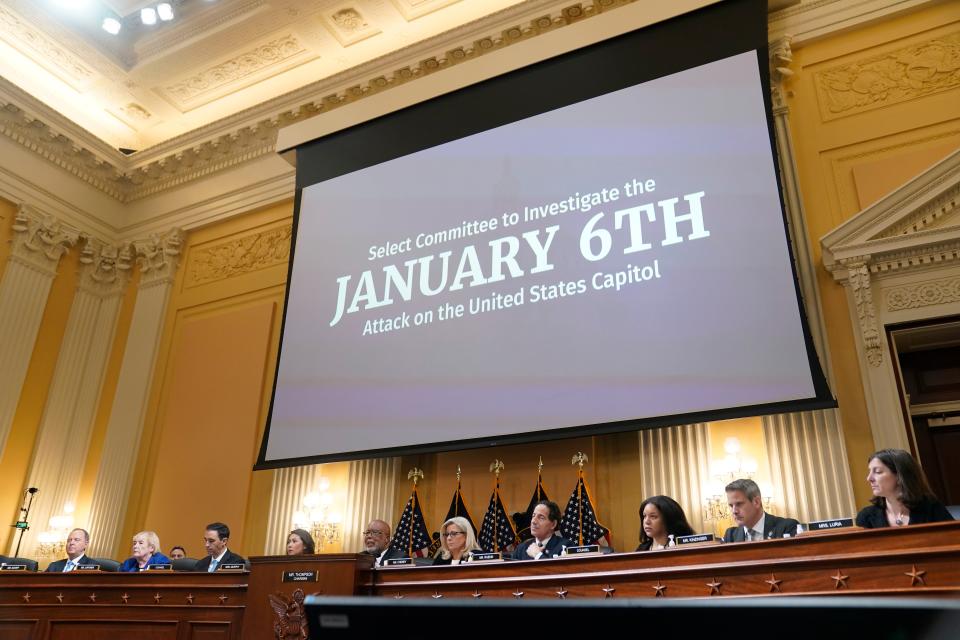
Trump allies discussed Executive Order 13848 as they sought to overturn election. What is it?
Evidence presented Tuesday by the Jan. 6 committee revealed that former President Donald Trump’s lawyers and allies suggested invoking an executive order for foreign interference in American elections, despite no evidence of such interference.
“He was very interested in hearing particularly about the CISA findings and the terms of 13848 that apparently nobody else had bothered to inform him of,” Powell said in a deposition.
Powell was referring to Executive Order 13848, which would grant the president emergency powers in the event of foreign interference in American elections.
That executive order was cited in a different draft executive order, pushed for by Trump’s outside advisers like lawyer Sidney Powell and retired Lt. Gen. Michael Flynn. It was never implemented, but would have commanded the secretary of defense to seize all voting machines. Powell would have been appointed special counsel to investigate election fraud under the draft executive order.
– Ella Lee
Committee schedules next Jan. 6 hearing for July 21
The select committee investigating the violent Capitol attack on Jan. 6, 2021, has set its eighth hearing.
It will begin at 8 p.m. Thursday, July 21 and will focus on how Trump spent the 187 minutes between the end of his “Stop the Steal” rally and the three hours of Capitol violence before he issued a tweet urging his supporters to go home.
Committee members said additional testimony from former White House counsel Pat Cipollone will also be shared during the next hearing.
- Candy Woodall
Thompson, Raskin put Jan. 6 in historical perspective
Members of the House Jan. 6 committee closed their seventh hearing on Tuesday by framing President Donald Trump’s actions as unprecedented in American history.
“The Watergate break in was like a Cub Scout meeting compared to this assault on our people and our institutions,” said Rep. Jamie Raskin, D-Md.
Rep. Bennie Thompson, the committee’s chairman, said government has held strong through centuries of turmoil.
“I am from a part of the country where had it not been for the federal government and the constitution, my parents and many more Americans like them would have continued to be treated as second-class citizens,” said Thompson, D-Miss.” The freedom to be able to vote without harassment, travel in relative safety and dine and sleep where you choose is because we have a government that looks over the wellbeing of its citizens.”
Thompson said the Jan. 6 attack was another test of the strength of the federal government, and he blamed Trump for sending the mob rather than stopping it.
“It was an attack on our democracy, on our constitution,” Thompson said. “A sitting president with a violent mob trying to stop the peaceful transfer of power from one president to another – It still makes my blood boil to think about that.”
Still to come: Committee to walk through Jan. 6 ‘minute by minute'
At the next hearing of the Jan. 6 committee, members plan to walk through the events of Jan 6, 2021, “minute by minute,” Rep. Liz Cheney, R-Wyo., said Tuesday.
Cheney emphasized that former President Donald Trump ignored “many pleas for help from Congress,” and staff who insisted he call off the attack. She also said Trump could have personally called the secretary of defense or his attorney general to help stop the attack but did not.
There were 187 minutes between Trump’s speech on the Ellipse and his tweet urging supporters to leave the Capitol that have not been fully explained.
– Erin Mansfield
Trump tried to contact a witness, Cheney says
In closing statements, Rep. Liz Cheney, R-Wyo., committee vice chair, said the panel learned that Trump tried to contact a witness after the last hearing held in June.
The witness, though part of the committee’s investigation, has not yet been seen in the hearings, Cheney said.
Cheney said the witness declined to answer or respond to Trump’s call, instead alerting their lawyer who then told the committee.
“This committee has supplied that information to the Department of Justice,” Cheney said. “Let me say one more time, we will take any effort to influence witness testimony very seriously.
– Chelsey Cox
Rioter who lost job upset that Trump is still promoting election lie
Stephen Ayres, an Ohio man criminally charged for his actions during the Capitol insurrection, said he lost his job and that Jan. 6 “changed my life, and not for the good.”
When asked how it makes him feel that Trump is still promoting falsehoods about the 2020 election results, Ayres told the committee it “makes me mad, I was hanging on to every word he said.”
Ayres said he’s concerned for the next election because “thousands and millions” like himself held onto Trump’s claims, many of whom he believed still are today.
– Katherine Swartz
Rioter who lost job upset that Trump is still promoting election lie
Stephen Ayres, an Ohio man criminally charged for his actions during the Capitol insurrection, said he lost his job and that Jan. 6 “changed my life, and not for the good.”
When asked how it makes him feel that Trump is still promoting falsehoods about the 2020 election results, Ayres told the committee it “makes me mad, I was hanging onto every word he said.”
Ayres said he’s concerned for the next election because “thousands and millions” like himself held onto Trump’s claims, many of whom he believed still are today.
– Katherine Swartz
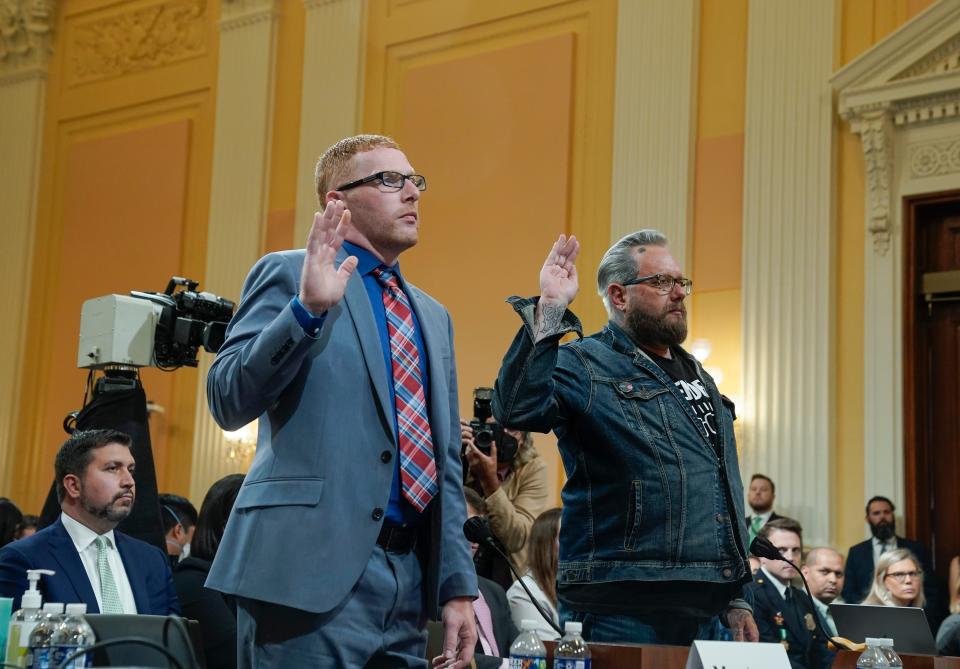
Ex-Oath Keeper said he’s scared of next election cycle
Former national media director for the Oath Keepers, Jason Van Tatenhove, said he is scared of the next election cycle after seeing Trump’s efforts to overturn the election and the attack on the Capitol.
“I do fear for this next election cycle because who knows what that might bring,” said Van Tatenhove. “If a president that is willing to try to instill and encourage, to whip up a civil war amongst his followers using lies and deceit and snake oil, regardless of the human impact.”
Van Tatenhove said if Trump is elected into office again, “all bets are off at that point.”
“I have three daughters, I have a granddaughter. And I fear for the world they will inherit if we don’t start holding these people to account," said Van Tatenhove.
– Kenneth Tran
Rioter says on Jan. 6, he thought election would still be overturned
Stephen Ayres, who was arrested for illegally entering the Capitol on Jan. 6, testified during Tuesday's hearing that he would have had reservations about going to the Capitol had he been aware former President Donald Trump had no evidence of election fraud. He also said he would not have stayed at the Capitol as long as he did had the former president told his supporters to leave earlier.
Ayres said he thought the election was going to be overturned on Jan 6. He said "everybody," thought Trump was going to be coming to Capitol, too.
"You know, he said in his speech, you know, kind of like he's gonna be there with us."
– Merdie Nzanga
Jan. 6 rioter blames Trump
Ayres testified how believed Trump’s false assertions about the 2020 election and being “pretty hardcore” into consuming social media posts about the contest being stolen.
When quizzed by Rep. Liz Cheney, R-Wyo., about whether it would have made a difference if he knew the president had no evidence of election fraud, Ayres said it would have.
“Who knows, I may not have even come down here then,” Ayres said.
– Phillip M. Bailey

Oath Keepers are ‘dangerous militia,’ group’s former spokesperson says
In testimony before the Jan. 6 committee Tuesday, former Oath Keepers spokesperson Jason Van Tatenhove described the group as a “dangerous” and “violent” militia.
“I think the best illustration for what the Oath Keepers are happened January 6, when we saw that stack military formation going up the stairs of our Capitol,” he said.
Van Tatenhove said that the Oath Keepers is largely driven by the ego of its founder and leader Stewart Rhodes, a Yale law school graduate who will stand trial in September for seditious conspiracy in relation to his involvement with the Jan. 6 Capitol attack.
– Ella Lee
Who is Stewart Rhodes: Vegas parking valet, Yale law graduate, unhinged Oath Keepers leader
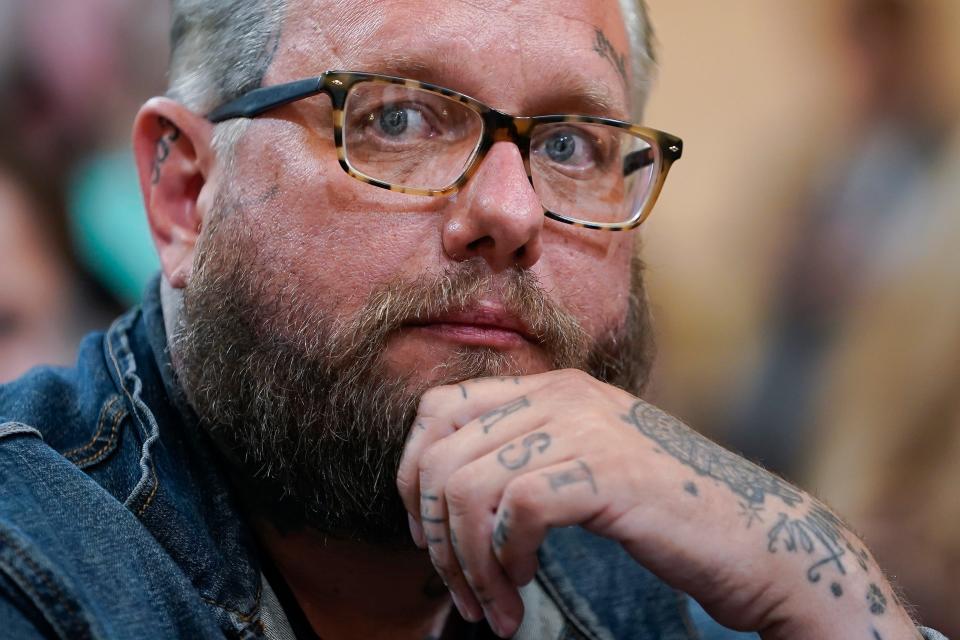
Brad Parscale connects Trump rhetoric to rioter’s death on Jan. 6
Former Trump campaign manager Brad Parscale said in text messages after the Jan. 6 Capitol riot that he felt guilty for his role in getting Trump elected and that it was Trump’s rhetoric that led to death of a rioter that day.
“A sitting president asking for civil war,” Parscale said in text messages to former White House press secretary Katrina Pierson revealed Tuesday by the committee investigating the attack. “This week I feel guilty for helping him win.”
Parscale said in another message: “Yeah. If I was Trump and knew my rhetoric killed someone."
Pierson tried to comfort Parscale in the exchange, saying “it wasn’t the rhetoric” that led to a woman dying at the Capitol.
“Yes it was,” Parscale said.
– Rick Rouan
Trump incited supporters against Pence
According to evidence, former President Donald Trump revised his planned speech to protesters at his Jan. 6 rally at the Ellipse to include references to former Vice President Mike Pence.
An email showed Trump instructed a speech writer to “REINSERT THE MIKE PENCE LINES. Confirm Receipt.”
The message was sent after Trump called Pence a “wimp” for refusing to comply with a scheme to alter the results of the 2020 presidential election by tampering with Electoral College electors. The Jan. 6 committee has outlined the plan, invented by former Trump lawyer John Eastman, over a series of hearings.
Protesters sought out Pence as they ransacked the Capitol on Jan. 6, 2021, according to evidence.
– Chelsey Cox
GOP lawmakers met with Trump about overturning election results
Several Republican members of Congress met with former President Donald Trump, adviser Rudy Giuliani and chief of staff Mark Meadows in the Oval Office to discuss what role Vice President Mike Pence could play in overturning election results.
According to White House visitor logs, members in attendance included: Brian Babin, R-Texas; Andy Biggs, R-Ariz.; Matt Gaetz, R-Fla.; Louie Gohmert, R-Texas; Paul Gosar, R-Ariz.; Andy Harris, R-Md.; Jody Hice, R-Ga.; Jim Jordan, R-Ohio; and Scott Perry, R-Pa.
Rep. Marjorie Taylor Greene, who at the time had been elected to Congress from Georgia but not sworn in, was also in attendance.
Rep. Stephanie Murphy, D-Fla. and committee member, said in the hearing that several of the representatives in attendance later requested pardons.
– Katherine Swartz
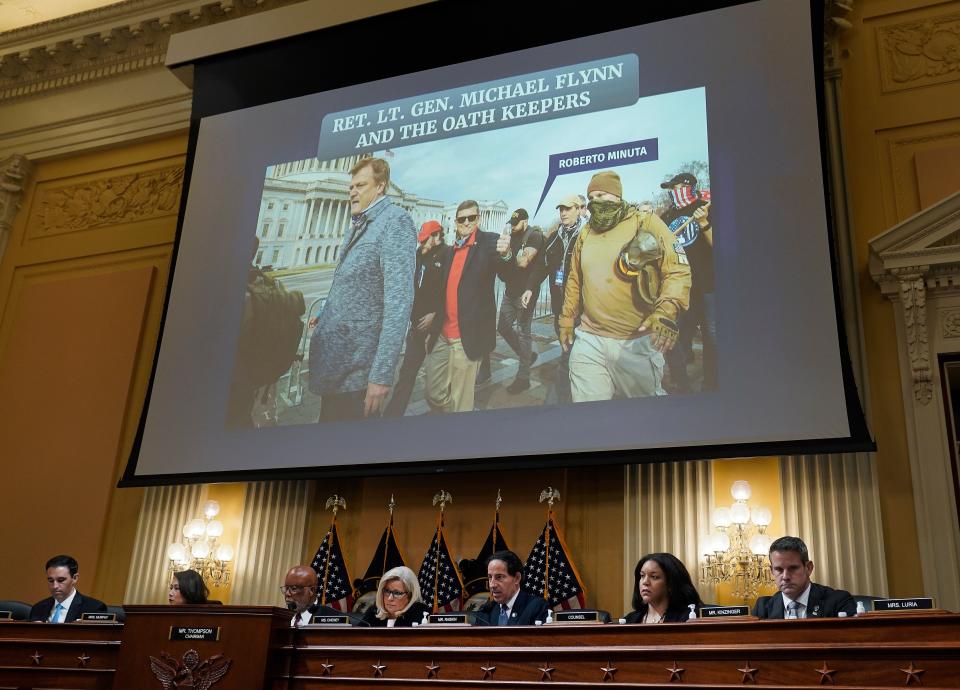
Republican congresswoman feared for safety from Trump supporters
Rep. Debbie Lesko, R-Ariz., told other members of Congress on Jan. 5, 2021, that she was concerned about members’ safety surrounding the next day’s vote to certify the election.
“I’m actually very concerned about this because we have who knows how many hundreds of thousands of people coming here,” Lesko said. She said without evidence the leftist group Antifa would be there before raising concerns about Trump supporters.
“We also have quite honestly, Trump supporters who actually believe that we are going to overturn the election, and when that doesn’t happen — most likely doesn’t happen — they are going to go nuts,” Lesko said.
– Erin Mansfield
Cipollone: Mike Pence should get Medal of Freedom
Former White House counsel Pat Cipollone said that former Vice President Mike Pence had no legal power to do anything related to the certification of the 2020 election except for what he did.
Cipollone told the committee that he suggested Pence should be awarded "the presidential Medal of Freedom for his actions."
– Merdie Nzanga
Kylie Kremer, rally organizer, knew Trump would order march to Capitol
The House select committee revealed never-before-seen text messages on Tuesday showing those who were behind the rally ahead of the Jan. 6 riot knew that President Donald Trump would call for a march to the Capitol.
In a series of messages obtained by the panel, Kylie Kremer, the organizer of the "Stop the Steal" rally, was speaking to Mike Lindell, CEO of MyPillow and a Trump confidante.
On Kylie Kremer: This mother-daughter duo planned the Jan. 6 rally. Now the House committee wants to hear from them, too.
Two days before the riot, Kremer said in the text messages how Trump is “going to have us march there,” meaning the Capitol. He then told Lindell to keep that information to himself because the president, during his rally speech, would "unexpectedly" instruct his supporters to go to the Capitol.
“The evidence confirms that this was not a spontaneous call to action, but rather was a deliberate strategy decided upon in advance by the president ,” Rep. Stephanie Murphy, D-Fla., a member of the committee, said.
– Phillip M. Bailey
Bannon, on Jan. 5: ‘All hell is going to break loose tomorrow’
On Jan. 5, Trump and former White House chief strategist Steve Bannon spoke twice. After their initial call, Bannon said on his podcast, “All hell is going to break loose tomorrow.”
“It’s all converging and now we’re on, as they say, the point of attack,” Bannon said. “Right, the point of attack tomorrow. I’ll tell you this. It’s not gonna happen like you think it’s gonna happen. It’s gonna be quite extraordinarily different. And all I can say is strap in.”
The committee revealed Trump and Bannon briefly spoke over the phone again for six minutes and the contents of the phone call are unknown.
– Kenneth Tran
Ex-Trump press secretary Katrina Pierson messaged Meadows with Jan. 6 concerns about Jan. 6
Katrina Pierson, a former Trump spokesperson, told the Jan. 6 committee that she directly raised concerns with former chief of staff Mark Meadows about some of the speakers scheduled to talk at the former president’s rally on Jan. 6, 2021.
Pierson primarily raised concerns over far-right conspiracy theorists Alex Jones and Ali Alexander because of their inflammatory rhetoric.
“I probably mentioned to him that they had already caused trouble in other capitals, or at previous events,” she said.
– Ella Lee
Oath Keepers formed alliances
The committee presented evidence from white supremacist, pro-Trump and anti-government groups showing their intent to join forces in protesting the results of the 2020 presidential election.
Kelly Meggs, indicted leader of anti-government group the Oath Keepers, outlined the plan in a Dec. 19, 2020, Facebook post.
“Well we are ready for the rioters, this week I organized an alliance between Oath Keepers, Florida 3%ers, and Proud Boys. We have decided to work together and shut this sh*t down,” read the post.
– Chelsey Cox
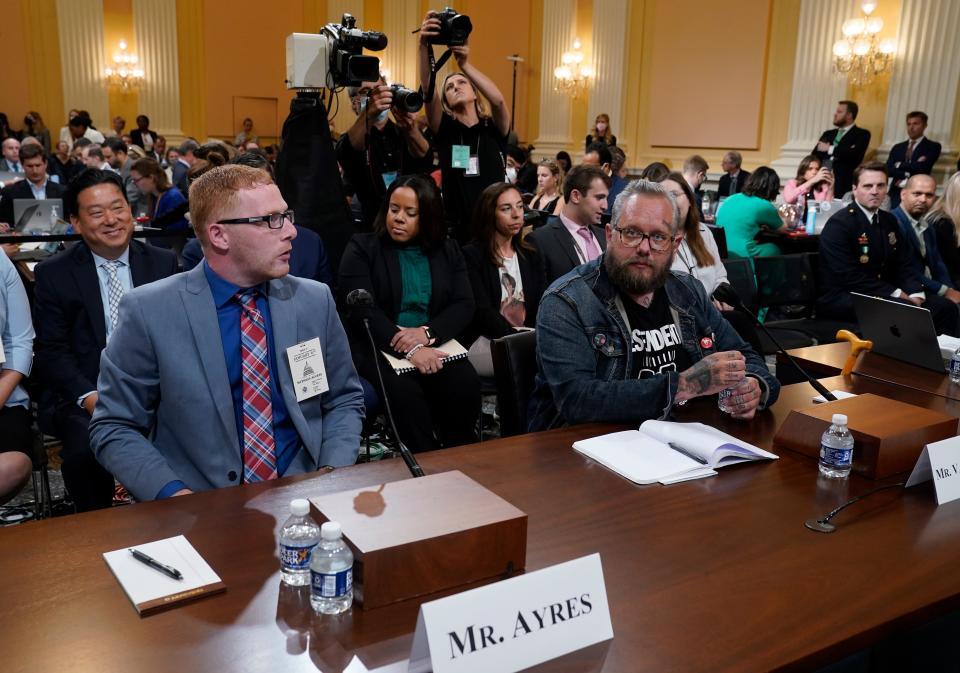
Raskin connects Flynn, Stone to Oath Keepers, Proud Boys
Rep. Jamie Raskin, D-Md., said Tuesday that Michael Flynn and Roger Stone both had connections to the Oath Keepers and the Proud Boys, showing photos of Flynn with members and pointing to communications between Stone and group leaders.
The committee showed a photos of Flynn, Trump’s former national security adviser, with an indicted member of the Oath Keepers, Robert Minuta, and one of the group’s leaders, Stewart Rhodes.
Stone communicated with top group leaders via an encrypted group chat called “Friends of Stone,” Raskin said.
– Rick Rouan
‘Nonaligned groups were aligning’ security expert says
A former homeland security leader in Washington, D.C., told the committee that the department had received intelligence of violent groups on the far-right uniting and planning to come to the nation’s capital.
“These nonaligned groups were aligning,” said Donnell Harvin, a professor at Georgetown Unviersity and the former chief of homeland security and intelligence for the government of the District of Columbia.
“All the red flags went up at that point,” Harvin said, “knowing that you have armed militia collaborating with white supremacy groups, collaborating with conspiracy theorist groups online, all towards a common goal.”
– Erin Mansfield
Who is Stephen Ayres?
One of two witnesses soon expected to testify before the Jan. 6 Committee is Stephen Ayres, one of many rioters who were arrested for illegally entering the Capitol on Jan. 6. He has also been charged with obstruction of justice for attempting to stop the certification of electors.
In an affidavit filed by the FBI related to his arrest, Ayres specifically referenced Trump’s Dec. 19 tweet saying there will be a “Big protest in D.C.” Ayres made several posts on Facebook leading up to Jan. 6 asking where Trump’s supporters will be. He also live-streamed the Capitol attack on Facebook at several points.
– Kenneth Tran
Trump’s tweet organized extremists around a single day
Prior to former President Donald Trump’s tweet on Dec. 19 calling his supporters to the Capitol on Jan. 6, there was no plan or single day that his supporters planned to come.
“People talked about going to D.C. when the election was over … after it was announced he was going to be there on the 6th, then anything else was shut out and it was just going to be on the 6th,” Jody Williams, former owner of far right website TheDonald.win, said in video testimony.
Rep. Jamie Raskin said Trump’s tweet created a “laserlike focus” on Jan. 6, mobilizing his followers over a singular date and plan that allowed for the mob mentality and widespread violence of the riot.
After Trump’s tweet, posts on Twitter and far-right websites focused their violent rhetoric around the that date. Followers wrote about the tunnels beneath the Capitol complex, suggestions for targeting members of Congress, with followers saying they were “ready to die for their beliefs.”
– Katherine Swartz
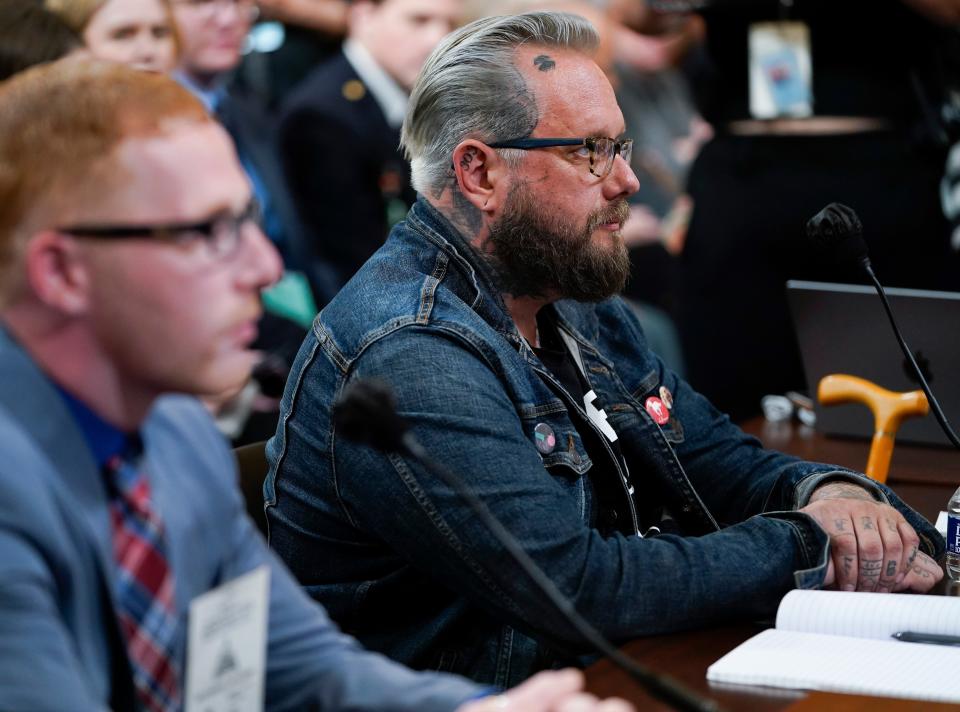
Ex-Twitter staffer: Trump stuck ‘a flag in DC on January 6th for his supporters to come and rally’
A former Twitter employee who spoke to the Jan. 6 committee said Trump’s tweet on Dec. 19, “was essentially sticking a flag in DC on January 6th for his supporters to come and rally.”
“Big protest in D.C. on January 6th. Be there, will be wild!” tweeted Trump on Dec. 19. The Twitter employee said reactions to Trump’s tweet made it “very clear that individuals were ready, willing and able to take up arms.” Trump appeared as a leader of their cause, according to the Twitter employee.
Users responded to Trump’s tweet with “locked and loaded" and “stand back, stand by.” The reactions to Trump’s tweet made the Twitter employee “absolutely” concerned that gatherings on Jan. 6 would turn violent.
– Kenneth Tran
Twitter ‘relished’ being Trump’s favorite
The Jan. 6 committee spoke with a former employee of Twitter who worked on the platform’s moderation team throughout 2020 and 2021.
In a taped testimony, the anonymous person, whose voiced was changed to protect their identity, said Twitter had considered adopting stricter content rules as a result of the former president telling the Proud Boys to “stand back, and stand by” during one of the 2020 presidential debates.
“My concern was that the former president for seemingly the first time was speaking directly to extremist organizations and giving them directives,” the employee said. “We had not seen that sort of direct communication before, and that concerned me.”
Twitter did nothing in the months leading up to Jan. 6, however.
The employee said Twitter’s leaders “relished” being Trump’s favorite social media platform, and that any other user would have been permanently banned “a long time ago.”
Trump was eventually banned on Jan. 8.
– Phillip M. Bailey
Trump supporters aimed for Jan. 6 protests after his tweeted invitation
Hours after former President Donald Trump tweeted his invitation for protests in Washington on Jan. 6, 2020, his supporters began organizing.
A committee member, Rep. Jamie Raskin, D-Md., said Women for America First had applied for a rally permit Jan. 22 and 23 – several days after President Joe Biden’s inauguration. But hours after Trump’s tweet Dec. 19, 2020, the group changed the permit to Jan. 6 for the rally where Trump spoke.
Ali Alexander, leader of the advocacy group Stop the Steal, registered the web site wildprotest.com, with comprehensive information about protest events in Washington with times, places, speakers and details about transportation, Raskin said.
“Trump’s purpose was to mobilize a crowd,” Raskin said.
– Bart Jansen
Giuliani, Herschmann traded insults
More provocative prerecorded testimony presented by the Jan. 6 committee showed different sides of the Trump faction siding with or against the former president’s election fraud claims.
Trump’s former lawyers Rudy Giuliani and Sidney Powell backed his fraud allegations, while White House counsel Pat Cipollone and adviser Eric Herschmann sought proof backing the claims.
A meeting between Trump’s advisers grew heated as Giuliani accused Cipollone and Herschmann of not acting aggressively enough, even once calling them the P-word.
“Excuse the expression, but that's almost certain the word was,” Giuliani said.
Herschmann, who said he’d had it with Giuliani after Giuliani screamed insults at him, told the attorney “either come over of sit your effin’ ass back down.”
– Chelsey Cox
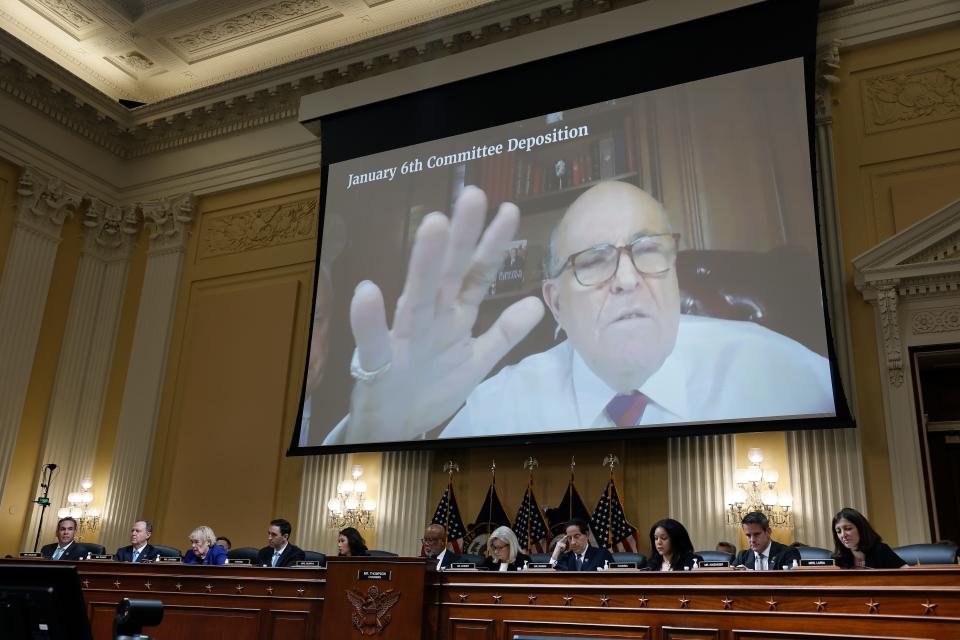
Trump tweet: ‘Be there - will be wild’
Unwilling to admit that his efforts to win back the White House had failed, former President Donald Trump on Dec. 19, 2020 took to Twitter to mobilize his followers, said Rep. Jamie Raskin, D-Md.
“How do you mobilize a crowd in 2020?” Raskin asked. “With millions of followers on Twitter, President Trump knew exactly how to do it.”
Trump sent out an “explosive invitation” to protest on Jan. 6, telling his supporters to “be there - will be wild” and repeating false claims of election fraud. His supporters responded “immediately,” Raskin said.
– Ella Lee
Dec. 18 meeting was marked by insults, verbal attacks
The Dec. 18 meeting in which Sidney Powell, Rudy Giuliani and Lt. Gen. Michael Flynn met to discuss overturning the election ended with the three Trump allies insulting people and verbally attacking the White House counsel, two former White House staffers said in videotaped testimony.
“It was not a casual meeting,” said Derek Lyons, a former White House staff secretary. “At times there were people shouting at each other, hurling insults at each other. It wasn’t sort of people sitting around on the couch just chit-chatting.”
Pat Cipollone, former White House counsel, said, “I remember the three of them were really sort of forcefully attacking me verbally," and he, Lyons, and lawyer Eric Herschmann were asking "one simple question, as a general matter, ‘Where is the evidence?’”
– Erin Mansfield
Giuliani escorted out of White House after heated meeting
Rudy Giuliani had to be escorted out of the White House at the end of a heated meeting among former President Donald Trump, the team of attorneys pursuing baseless claims of election fraud and White House lawyers.
Former White House aide Cassidy Hutchinson captured the moment in a photograph the committee showed Tuesday. Rep. Jamie Raskin, R-Md., said the photo showed then-White House chief of staff Mark Meadows escorting Giuliani, Trump’s personal lawyer, off the grounds to “make sure he didn’t wander back into the mansion.”
“The west wing is UNHINGED,” Hutchinson said in a text message that night, according to the committee.
– Rick Rouan
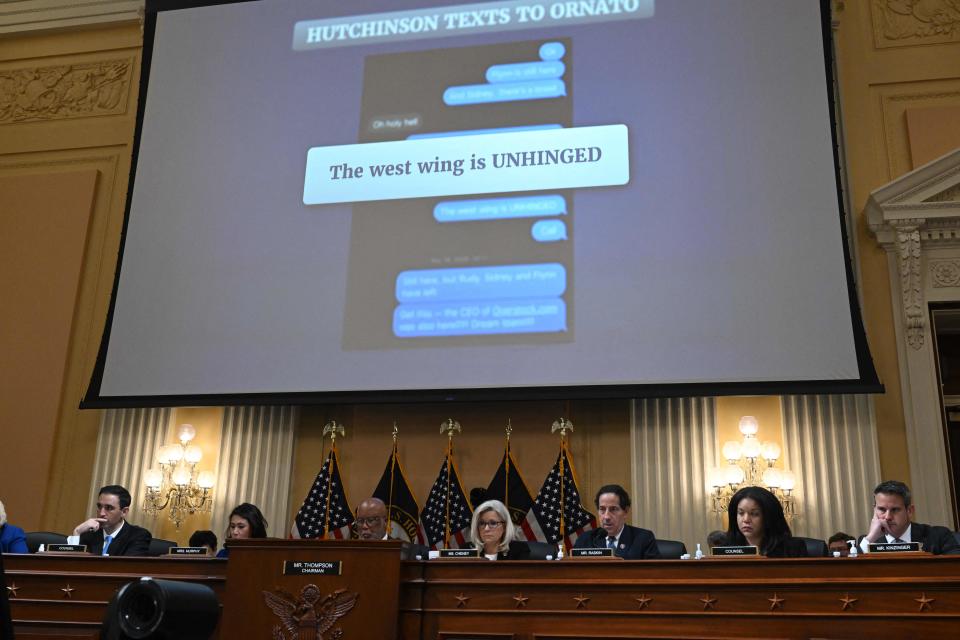
Trump advisers drafted order for Pentagon to seize voting machines
Former President Donald Trump’s outside advisers, including lawyer Sidney Powell and retired Lt. Gen. Michael Flynn drafted an executive order Dec. 16, 2020 – two days after the Electoral College voted to say Joe Biden won the election – to have the Defense Department seize voting machines.
A committee member, Rep. Jamie Raskin, D-Md., quoted from the draft order: “Effective immediately, the Secretary of Defense shall seize, collect, retain and analyze all machines…”
Raskin said the executive order, which wasn’t implemented, also called for Powell to be appointed special counsel to investigate election fraud.
Former Attorney General Bill Barr called the allegations voting machines were being manipulated “nonsense” and refused to seize voting machines.
“I told him that it was crazy stuff and they were wasting their time on that and it was doing a grave disservice to the country,” Barr said in videotaped testimony.
Former White House counsel Pat Cipollone opposed Powell’s appointment.
“I was vehemently opposed,” Cipollone said. “I didn’t think she should be appointed to anything.”
– Bart Jansen
Former Overstock.com CEO among Trump’s confidantes
Along with retired Lt. Gen. Michael Flynn and attorney Sidney Powell, former White House counsel Pat Cipollone was shocked to find Patrick Byrne, the former CEO of Overstock.com, alone with Trump in the Oval Office.
“I walked in, I looked at him and I said ‘Who are you?’ And he told me,” Cipollone testified. “I had never heard of who this guy was.”
Byrne, Flynn, Powell and others met alone with Trump for at least 10-15 minutes without White House staff’s knowledge.
“I don’t think any of these people were providing the president with good advice, so I didn’t understand how they had gotten in,” Cipollone said.
– Katherine Swartz
Raskin describes heated White House meeting between outside and internal advisers
Rep. Jamie Raskin, D-Md., described a heated meeting between Trump’s outside advisers and White House advisers. The meeting included Sidney Powell, former national security adviser Michael Flynn and former CEO of overstock.com Patrick Bryne, all conspiracy theorists who have made false claims the election was stolen.
The group of outside advisers “were able to speak with the president by himself for some time,” according to Raskin. White House officials were apparently unaware this meeting was happening, and when they found out, a “heated and profane clash,” ensued between the two groups.
The clash included “personal insults, accusations of disloyalty to the president, and even challenges to physically fight," said Raskin.
– Kenneth Tran
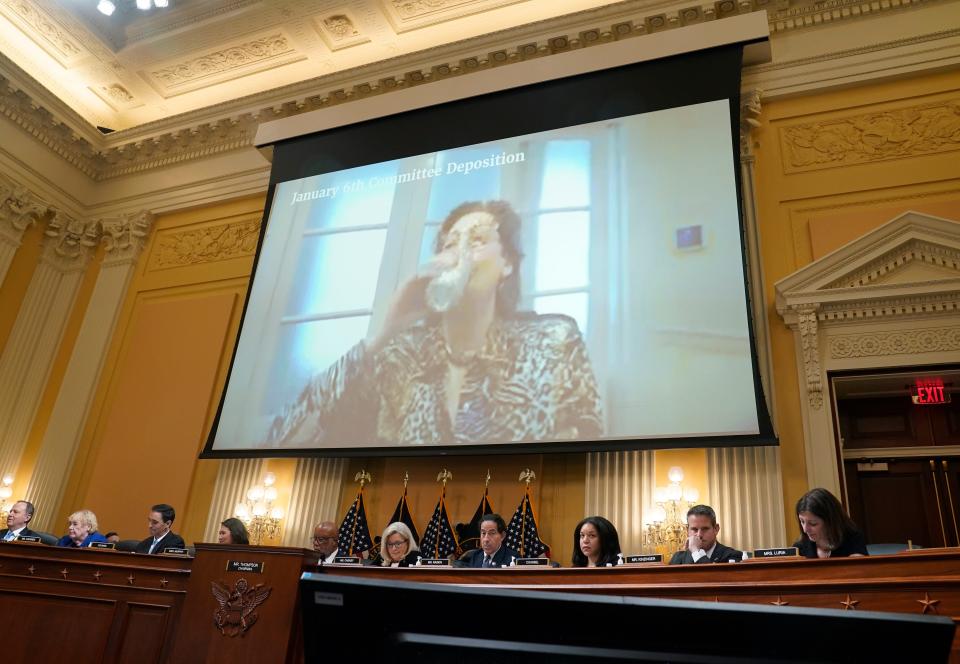
White House general counsel slams Sidney Powell
One of the jaw-dropping moments from Tuesday’s hearing was how Trump wanted to seize voting machines in the aftermath of losing the 2020 election.
Former White House lawyer Pat Cipollone explained in taped testimony how the president had an unplanned meeting with outside advisors, including Trump campaign lawyer Sidney Powell, about the plan.
"It's a terrible idea for the country," he said. "That's not how we do things in the United States."
The committee showed a draft of an executive order by Trump that would have empowered the secretary of defense to seize voting machines, and appoint a “special counsel” who could charge people with election crimes. Trump had considered Powell for the position of special counsel, according to the panel.
Many will recall Powell as the face of the campaign’s efforts to overturn the election, including false claims that foreign governments had interfered in the 2020 contest.
“I was vehemently opposed,” Cipollone said. “I didn’t think she should be appointed to anything.”
– Phillip M. Bailey
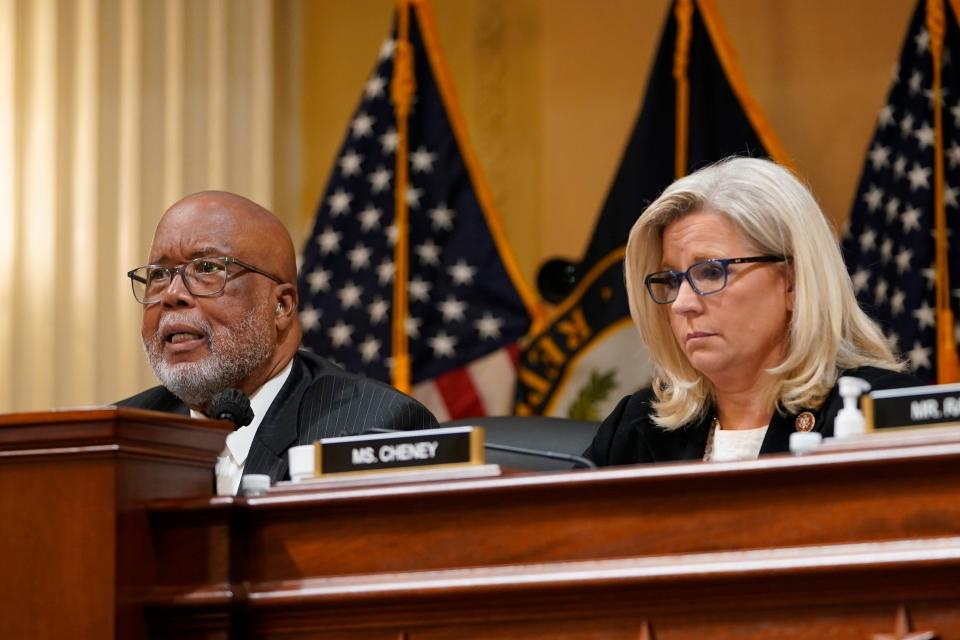
Hutchinson: John Ratcliffe feared Trump election challenges could 'spiral out of control'
In testimony to the Jan. 6 committee, former Mark Meadows aide Cassidy Hutchinson said that Trump’s director of national intelligence, John Ratcliffe, told her he thought that the former president’s challenges to the election could “spiral out of control” and become potentially “dangerous.”
Ratcliffe, a Republican, also previously served as a Texas U.S. representative from 2015 to 2020.
– Ella Lee
Life after the White House: Trump administration officials say Dec. 14 was key date
Multiple White House officials told the House Jan. 6 committee that they believed the Trump administration's days were numbered after the Electoral College votes were cast on Dec. 14.
Former White House press secretary Kayleigh McEnany, senior adviser Ivanka Trump and deputy press secretary Judd Deere all said in recorded testimony that Dec. 14, 2020, was a key date in the conclusion of the Trump administration.
Trump’s legal challenges of the 2020 election results all had failed, and the Electoral College had met to cast electoral votes that delivered Joe Biden’s victory.
McEnany said after Dec. 14 that she “began to plan for life after the administration.” Ivanka Trump agreed that Dec. 14 was an important day for the end of the administration, saying “I think it was my sentiment probably prior as well.”
– Rick Rouan
Raskin: Meeting described as 'craziest meeting of Trump presidency'
Rep. Jamie Raskin, D-Md., said during Tuesday's hearing that former President Donald Trump's advisers visited him on Dec. 18. The meeting was described as "unhinged, not normal," and the "craziest meeting" of Trump's presidency.
Raskin also said there has never been a time when a president asked a crowd to gather at the Capitol to fight the "certification of electoral results."
– Merdie Nzanga
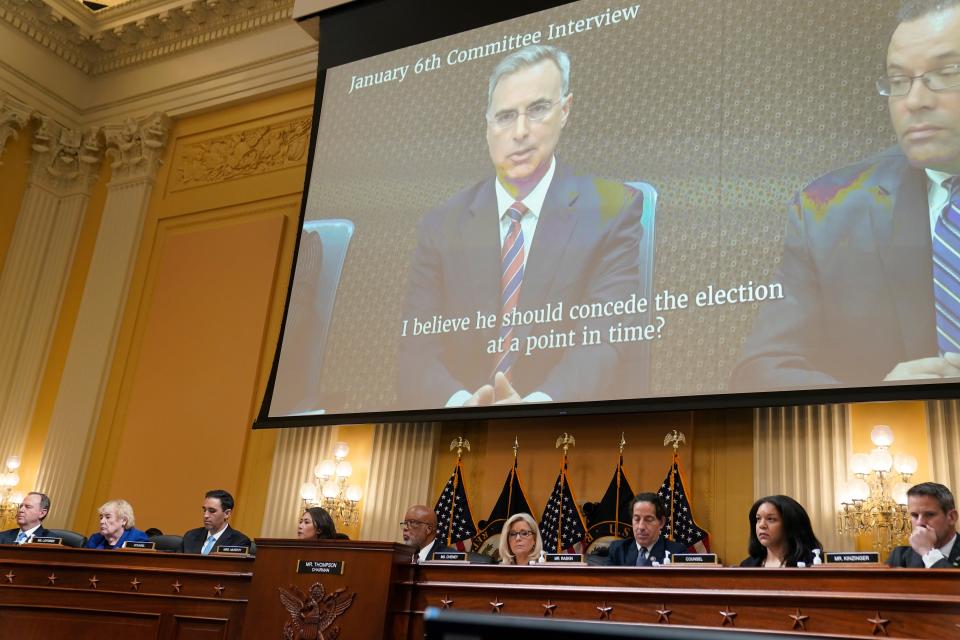
Meadows told Cipollone that Trump would make a ‘graceful exit’
Former White House counsel Pat Cipollone told the Jan. 6 committee in prerecorded testimony that Mark Meadows, former Trump chief of staff under the Trump administration, insisted Trump would participate in the peaceful transfer of power.
Meadows was said to assure both Cipollone and former Attorney General Bill Barr that Trump would agree to a “graceful exit” by conceding the 2020 presidential election around Nov. 23, 2020.
“I will say that that is a statement and a sentiment that I heard from Mark Meadows,” Cipollone said.
– Chelsey Cox
Eugene Scalia told Trump to concede following legal defeats
Eugene Scalia, then-secretary of labor to Trump and son of late Supreme Court Justice Antonin Scalia, advised former President Donald Trump to concede the election following a series of legal losses.
In videotaped testimony to the Jan. 6 Committee, Scalia said he spoke to Trump on Dec. 14 – the same day electors met in each state to certify Biden’s victory – and told him he “thought that it was time for him to acknowledge that President Biden had prevailed in the election.”
Since legal processes in dozens of states had been shot down by judges and no evidence of widespread fraud had been found, Scalia told Trump it was time to accept he had lost the election.
Instead, four days later, Trump called out to his supporters over Twitter to protest at the Capitol on Jan. 6.
– Katherine Swartz
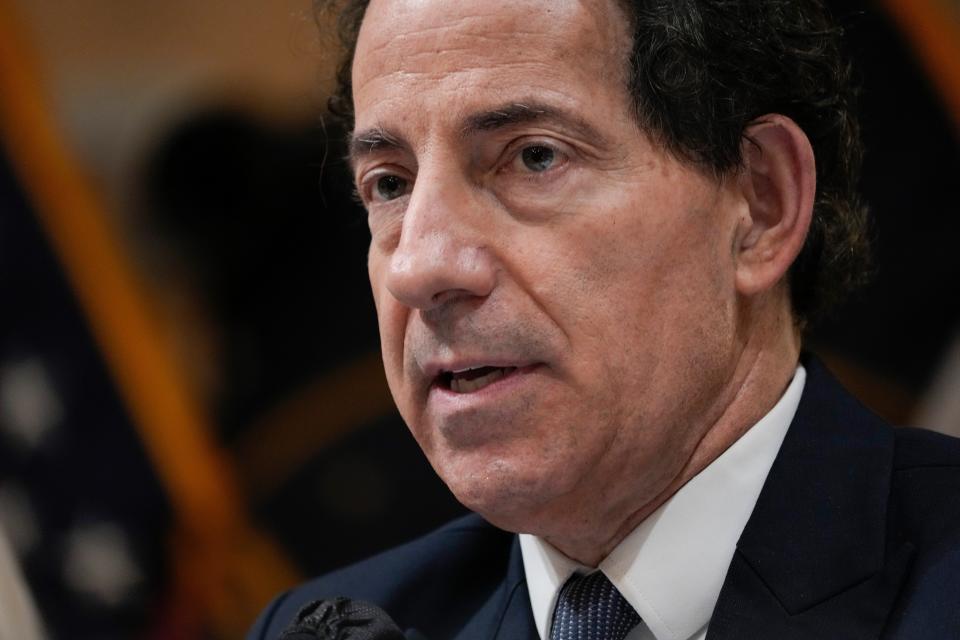
Pat Cipollone said he thought Trump should concede
Former White House Counsel Pat Cipollone said he though the process for deciding the 2020 election had ended by mid-December, just after the Electoral College met to cast formal votes for president.
“Did I believe she should concede the election at a point in time?” Cipollone asked the Jan. 6 committee in a videotaped interview. “Yes I did.”
He pointed to comments from then-Senate Majority Leader Mitch McConnell on Dec. 15, 2020, saying that the process had already played out, and added, “That would be in line with my thinking on these things.”
– Erin Mansfield
‘Three rings of interwoven attack’ leading up to Jan. 6
Rep. Jamie Raskin, D-Md., outlined “three rings of interwoven attack,” that were a part of Trump's efforts to overturn the election which resulted in the Capitol being attacked.
In the inner ring, Raskin described Trump’s internal efforts of trying to persuade Vice President Mike Pence to reject certain electoral votes, effectively overturning the election and keeping Trump in office, which “would have been a fundamental and unprecedented breach of the Constitution,” said Raskin.
In the middle ring, Raskin said Trump put a target on Congress’ back, which encouraged far-right extremist groups “to coordinate a massive effort to storm, invade, and occupy the Capitol.”
And the outer ring was the fruition of Trump’s efforts on the day of the Capitol attack, as “thousands of enraged Trump followers thoroughly convinced by the Big Lie,” converged upon the Capitol, said Raskin.
– Kenneth Tran
Murphy: Trump tweet was a ‘call to action’
Rep. Stephanie Murphy, D-Fla., who is co-leading Tuesday’s hearing, outlined how Trump used social media as a bullhorn to summon his most radical supporters to help overthrown the 2020 election.
The former president, Murphy said, had “called for backup” in a Dec. 19 tweet in order to pressure Vice President Mike Pence and members of Congress.
“Big protest in D.C. on January 6th,” Trump tweeted at the time. “Be there, will be wild!”
Murphy said the message was more than just a “call to action” but also served as a “call to arms” for his loyal base to help Trump steal the election.
“It’s clear the president intended the assembled crowd on Jan. 6 to serve his goal,” she said.
– Phillip M. Bailey
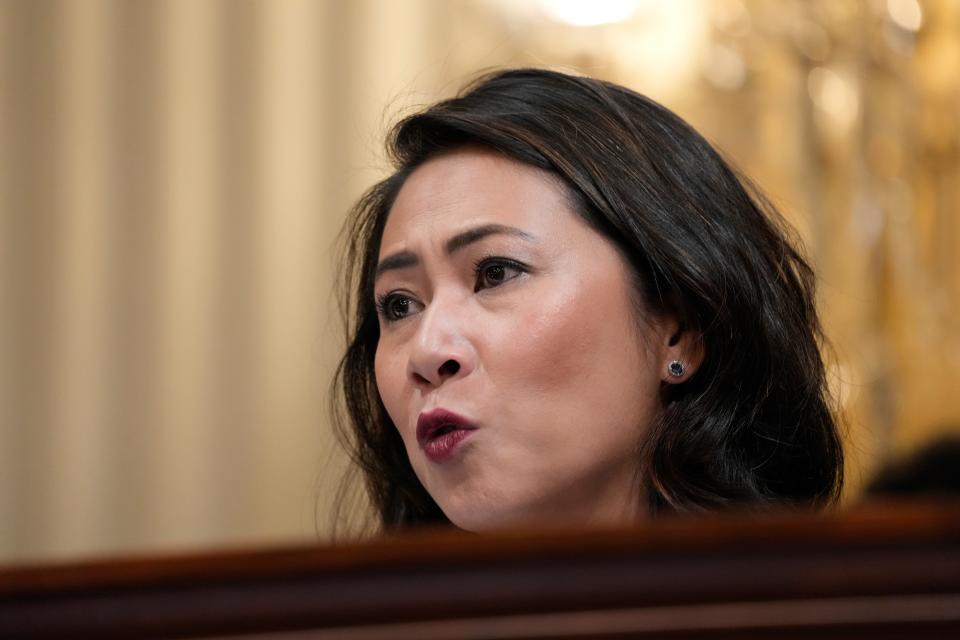
Trump not ‘an impressionable child,’ Cheney says
The vice chair, Rep. Liz Cheney, took direct aim at former President Donald Trump by arguing that his own White House advisers and Justice Department officials told him he lost the 2020 election and yet he willfully refused the accept that conclusion.
“The strategy is to blame people his advisers called ‘the crazies’ for what Donald Trump did,” said Cheney, R-Wyo. “This, of course, is nonsense. President Trump is a 76-year-old man. He is not an impressionable child. Just like everyone else in our country, he is responsible for his own actions and his own choices.”
Cheney argued Trump had access to more detailed information than almost anyone else.
“No rational or sane man in his position could disregard that information and reach the opposition conclusion,” Cheney said. “Donald Trump cannot escape responsibility by being willfully blind.”
– Bart Jansen
Cheney: Trump orbit changed approach to committee
In her opening remarks, Rep. Liz Cheney, R-Wyo., said that witnesses and lawyers in former President Donald Trump’s orbit have changed their approach to the Jan. 6 committee investigating the Capitol attack since it began its hearings.
Before the hearings began, the approach taken by Trump allies was to “deny and delay,” Cheney said. Now, Trump’s allies and former members of his administration agree the committee has turned up several truths.
“Today, there appears to be a general recognition that the committee has established key facts, including that virtually everyone close to President Trump, his Justice Department officials, his White House advisors, his White House Counsel, his campaign, all told him the 2020 election was not stolen.”
– Ella Lee
Cassidy Hutchinson on pardons: Trump allies Rudy Giuliani and Mark Meadows sought pardons related to Jan. 6 attack, testimony reveals
Cheney: Cipollone testimony 'met our expectations'
Rep. Liz Cheney said during her opening statement on Tuesday that former White House lawyer Pat Cipollone’s testimony before the House Jan. 6 committee had “met our expectations.”
The committee had issued a subpoena for Cipollone to speak to the committee, and he appeared before the committee last week.
“Mr. Cipollone’s testimony met our expectations,” said Cheney, the committee’s vice chair and its top Republican. “We will save for our next hearing President Trump’s behavior during the violence of Jan. 6.”
– Rick Rouan
Who is Jason Van Tatenhove?
Tuesday's hearing will focus on whether Trump and his allies coordinated with violent extremist groups to incite a mob to breach the U.S. Capitol. One witness set to testify in today’s hearing is Jason Van Tatenhove, former national media director for the Oath Keepers, a violent alt-right extremist organization that was present at the Capitol attack.
Van Tatenhove is expected to testify about how Stewart Rhodes, founder and leader of the Oath Keepers, started and kept the organization running through far-right conspiracy theories and propaganda. Van Tatenhove was a spokesperson for the Oath Keepers from 2014 to 2017, and he has since had no affiliation with the group.
The Department of Justice Department has charged several members of the Oath Keepers with seditious conspiracy and obstruction in connection with the Capitol attack and their attempt to stop the certification of the 2020 election.
– Kenneth Tran
Who are the Proud Boys? Who are the Oath Keepers?
The Proud Boys is an extremist group started in 2016 whose members describe themselves as promoting “Western chauvinism.” The group was founded by Miami native Henry “Enrique” Tarrio, who also served as the Florida state director for Latinos for Trump.
Founded in 2009 by Elmer Stewart Rhodes, the Oath Keepers is a paramilitary group that actively recruits law enforcement and military veterans. The group’s members have been involved in armed standoffs with the federal government and have shown up armed to public events saying they are security.
The Department of Justice has charged members of both groups, in separate cases, with seditious conspiracy, the most serious charges that have come out of the events of Jan. 6, 2021.
– Erin Mansfield
Pat Cipollone testimony to be shared
The Tuesday hearing is the first since former White House lawyer Pat Cipollone testified Friday behind closed doors. Video recordings of his testimony will be shared during the Tuesday hearing, continuing a format the committee has used throughout the first six hearings.
He is considered a key witness because of his access and involvement with the former president, especially during Trump's final months in office. Cipollone testified for more than eight hours Friday.
"He was aware of every major move, I think, that Donald Trump was making to try to overthrow the 2020 election and essentially seize the presidency," committee member Rep. Jamie Raskin, D-Md., told CBS' "Face the Nation" on Sunday.
- Candy Woodall and Bart Jansen
The attack, extremists, Trump: Jan. 6 hearing to focus on Trump mob. A breakdown of the Proud Boys, Oath Keepers and the attack.
Murphy and Raskin will lead today’s hearing
Reps. Stephanie Murphy, D-Fla., and Jamie Raskin, D-Md., will lead today’s proceedings into the role former President Donald Trump had in summoning far right extremist groups the Proud Boys and Oathkeepers to the Capitol on Jan. 6, 2021.
In social media posts ahead of the hearing, both Raskin and Murphy emphasized former Trump’s tweet on Dec. 19 as a key moment in mobilizing the extremist groups.
“When he sent this tweet, Trump became the first president in American history to call for a protest against the peaceful transfer of power,” Raskin said on Twitter.
Murphy said on Twitter that Trump’s tweet “activated domestic extremist groups” and that some members of Congress “amplified that message, all leading to the attack on January 6th.”
– Katherine Swartz
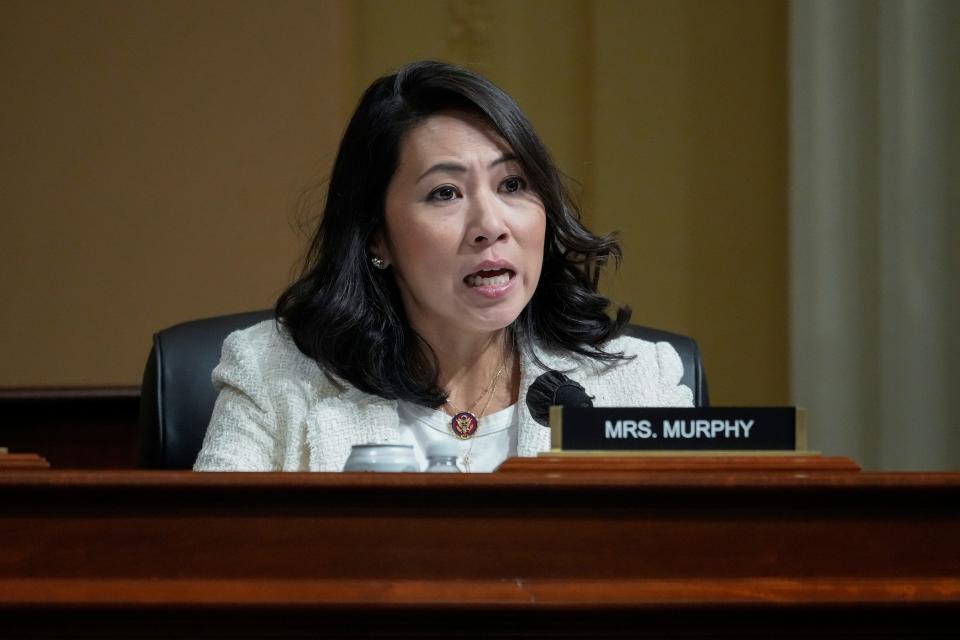
Steve Bannon offers to testify, but contempt trial won't be delayed
The hearing comes a day after Trump ally Steve Bannon asked a federal court to delay his contempt trial for defying a committee subpoena.
Bannon offered to testify, after refusing since the subpoena was issued in September. But federal prosecutors argued the trial should proceed and a judge denied his request to delay the trial Monday.
"If he wants to come in, I'm sure the committee would be very interested in hearing from him," Raskin said.
His testimony is not anticipated Tuesday.
- Bart Jansen and Candy Woodall
Bannon trial won't be delayed: Steve Bannon's request to delay contempt trial denied after he offered to testify before Jan. 6 panel
Trump fueled mob with fiery language
While Trump fought election results in dozens of unsuccessful lawsuits, he invited protesters to Washington with a tweet Dec. 19, 2020.
"Big protest in D.C. on January 6th," Trump said. "Be there, will be wild!"
Trump also urged the crowd to march to the Capitol, where he said he would join them in cheering on senators and representatives challenging the election results. After a dispute with his security detail, he never went.
"You'll never take back our country with weakness," Trump told the crowd. "You have to show strength and you have to be strong."
-Bart Jansen
What Trump did on Jan. 6: On Jan. 6, Trump was out of public view as aides urged him to act. A breakdown of those 187 minutes.
Capitol Police were bracing for extremist groups
Capitol Police released a special assessment Jan. 3, 2021, anticipating members of the Proud Boys and other groups were expected and would target Congress, according to the Jan. 6 committee's vice chair, Rep. Liz Cheney, R-Wyo.
"President Trump summoned the mob, assembled the mob, and lit the flame of this attack," Cheney said at the June 9 hearing. "The attack on our Capitol was not a spontaneous riot."
A White House aide, Cassidy Hutchinson, testified June 28 that she kept hearing about Oath Keepers and Proud Boys while planning for the Jan. 6 rally when Trump's personal lawyer, Rudy Giuliani, was around.
"Things might get real, real bad on January 6th," Hutchinson quoted former chief of staff Mark Meadows as telling her.
-Bart Jansen
What has the committee already covered?
Throughout the first six public hearings, the Jan. 6 committee has sought to prove the former president oversaw and coordinated “a sophisticated seven-part plan to overturn the presidential election and prevent the transfer of power,” according to committee's vice chair, Rep. Liz Cheney, R-Wyo.
It's an investigation that gained momentum in June, most notably with its star witness Cassidy Hutchinson. The former top White House aide testified June 28 and described how Trump knew some of his angry supporters were armed as he directed them to walk down Pennsylvania Avenue to the U.S. Capitol.
The committee held six hearings in June. The hearings covered:
How Trump led and directed efforts to overturn the election.
How the former president pushed false claims of election fraud after his aides told him he lost the election.
Trump’s pressure on former Vice President Mike Pence, on state officials in Arizona and Georgia and on Justice Department officials.
White House aide Cassidy Hutchinson’s perspective on Trump’s response.
-Candy Woodall and Bart Jansen
This article originally appeared on USA TODAY: Jan. 6 hearing focuses on extremist groups, Trump's role: Day 7 recap
